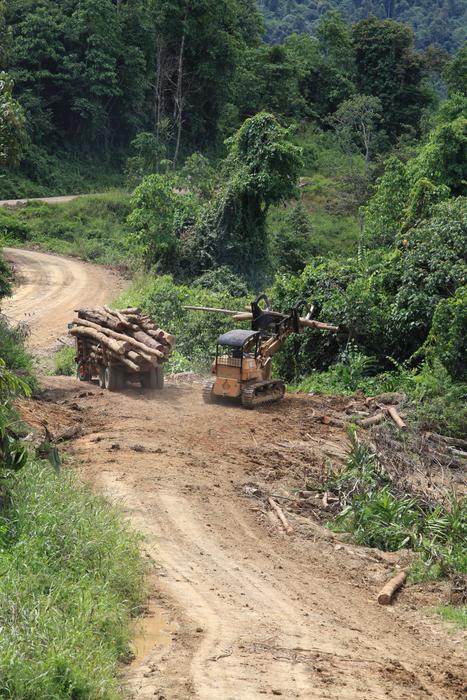Researchers have analysed data from 127 studies to reveal ‘thresholds’ for when logged rainforests lose the ability to sustain themselves.

Credit: Zoe G. Davies
Researchers have analysed data from 127 studies to reveal ‘thresholds’ for when logged rainforests lose the ability to sustain themselves.
The results could widen the scope of which forests are considered ‘worth’ conserving, but also show how much logging degrades forests beyond the point of no return.
The first-of-its-kind study, led by researchers from the Department of Life Sciences at Imperial College London with collaborators from around the world, is published today in Nature. The team looked at data from 127 plant and animal surveys covering more than 10 years in the same site in Sabah, Malaysia.
The site, named the Stability of Altered Forest Ecosystems (SAFE) Project, includes a full gradient of landscapes, including unlogged primary forests, selectively logged forests, protected riverside ‘buffer’ forests, and forests converted into oil palm plantations that represent 99% of forest removal.
While no level of forest degradation through logging was too low to have an impact on the ecosystem, the results showed that forests that had lost less than 29% of ‘biomass’ (total weight of organic matter) retained relatively high biodiversity and ecological value, and, if left alone, were likely to recover.
Preventing extinction
Above 68% biomass removal, however, many types of plants and animals formed communities that were effectively ‘scrambled’ by extinctions and invasive species. In these areas, serious proactive conservation would be needed to maintain biodiversity. Beyond this, the forests rapidly lost the ability to sustain themselves – to act as complete, functioning ecosystems.
Lead researcher Professor Robert Ewers, from the Department of Life Sciences at Imperial College London, said: “There has been a tendency in conservation to think of pristine forests as the only ones worth investing in – that logged forests were not worth looking at.
“What we’ve shown is that the potential ‘conservation estate’ is much larger than we thought, and while pristine forests are shrinking worldwide, this doesn’t mean all hope is lost, and there are other forests we can protect to preserve biodiversity.”
Co-author Dr Will Pearse, from the Department of Life Sciences at Imperial College London, said: “Pristine forests will always be the ideal, but there shouldn’t be a binary view of what’s worth preserving and what’s not. Some degree of logging may always be necessary, and while these forests are not the same as pristine ones, at certain thresholds they can still sustain themselves as functioning ecosystems.”
While the exact figures for forest destruction thresholds may vary across different environments, the study shows these can be found, with the right data.
Professor Ewers added: “A study like this has never been done, where so much data across landscapes, species and time have been collected together to determine critical thresholds. We now have a framework for assessing where these change points might be in other ecosystems.
“This is hopeful for conservation, giving us the tools to plot a course out of the extinction crisis more quickly.”
Nature worth preserving
Governments and policymakers in different countries use various measures to assess the likelihood of logging causing serious harm to local ecosystems. However, these can be imprecise as there isn’t a universal definition for which environments can be classified as forests.
Every environment is different, but the researchers think their results should be broadly applicable across the tropical rainforests of South-East Asia.
The Malaysian SAFE Project surveys counted the occurrences of 590 plants (including grasses, herbs, and woody trees), 88 mammals (including bats), 161 birds, 9 reptiles, 42 amphibians, 26 fish, and 635 invertebrates (including 263 beetles, 199 moths and butterflies, 130 ants, and 33 spiders), noting the impacts on each of the extent of logging damage.
Co-author Dr David Orme, from the Department of Life Sciences at Imperial College London, said: “Of course, we’ve known about the impacts of logging on biodiversity for a long time, but it’s has been hard to pin down when that damage starts to bite. That’s partly because earlier studies have tended to look at different taxa, such as trees or birds, but here we have been able to include much wider data from across the tree of life.”
Dr Pearse added: “Hundreds of person-hours have gone into getting this result, but it goes to show it was worth it. There’s been a self-sustaining myth that certain species and organisms would only be found in pristine forests, so nobody looked for them in logged forests. But now we have looked, we have found a lot of these ‘trashed’ forests host a surprising amount of biodiversity.”
Co-author Dr Cristina Banks-Leite, from the Department of Life Sciences at Imperial College London, said: “Ecological thresholds are great tools that can be easily applied in conservation and management. For instance, thresholds found elsewhere have been used for deciding how much area needs to be reforested or preserved.
“The thresholds we identified in our study can also point to where restoration projects would get the best return to investment – changes in biodiversity are faster below 30% and above 70% biomass loss, which suggests that any improvement on habitat in these areas would lead to dramatic changes in biodiversity.”
Virtual ecosystem
The team are now constructing a ‘Virtual Ecosystem’ that can track the birth, growth, reproduction and death of organisms within a changing ecosystem, and are planning to use the data from this study to generate a virtual model of a Bornean rainforest.
This will allow researchers to address ecological questions that cannot be answered through field observations, such as how to optimize the ecological recovery of degraded tropical forests.
Journal
Nature
Article Title
Ecological thresholds for adding degraded tropical rainforests to the conservation estate
Article Publication Date
17-Jul-2024



